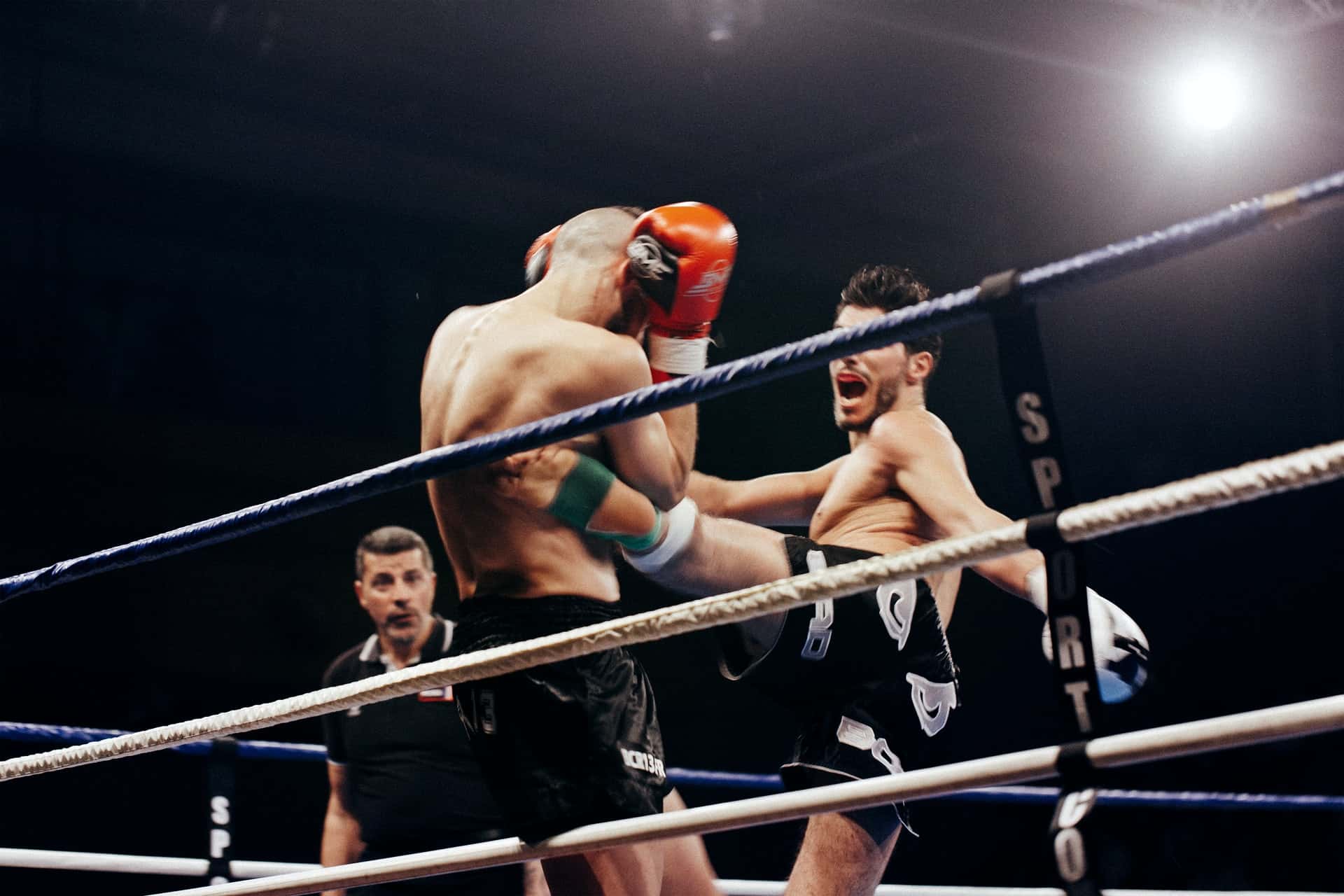More and more professional and amateur kickboxers are leaning toward strength training to make them better kickboxers. For good reason, whipping those kicks into devastating knockouts takes impressive speed and power.
Kickboxers require high levels of lower-body speed and power. Strength training can be performed on the same day as kickboxing training, preferably after kickboxing separated by at least 6 hours.
Before undertaking a strength training program, it’s important to know the strength and injury profiles of kickboxing so you can laser target your training to reducing the risk of common kickboxing injuries and enhance your performance.
Kickboxing Injury Profile
In striking-based combat sports like kickboxing, injuries are bound to happen. The vast majority of these injuries occur to the head (51%) and the lower limbs (40%) [1]. This is the most comprehensive injury study to date that spans over 16 years of injuries.
The large number of injuries to the legs and head are likely due to the fact the legs are used to both deliver forceful strikes, but also defend against leg attacks.
Discover The Little Known Secrets For Unlocking Devastating KO Power!
Heavy hands are built doing these things...
One way that has been recommended to reduce the rate of injury is to decrease the amount of full-contact sparring and replace it with sport-specific interval training [5].
Kickboxing Strength Profile

There is very little research investigating the strength profile of high-level kickboxers. In two studies, elite professional kickboxers of Canada and Portugal displayed peak torque (rotational force) of the quadriceps during knee extension at fast and slow speeds much greater than elite wrestlers and college football players but slightly lower than sprinters and jumpers [2,3].
In regional and national level kickboxers, an average jump height of 39 cm has been found [4]. There seems to be higher than Olympic wrestlers and Judo athletes but on par with BJJ athletes.
Unfortunately, this is all of the current evidence relating to the strength profile of kickboxers. It suggests that kickboxers possess the ability to produce a lot of force quickly with the lower body.
Kickboxing Strength Training Program
From the research, we know kickboxing requires high levels of lower-body speed and power. That means our strength training program needs to be geared towards these qualities. That doesn’t mean we ignore strength.
Strength, to a certain extent, can provide the foundation for speed and power.
This will be an example of a twice-a-week strength training program that encompasses two distinct phases.
Phase 1
Day 1
Exercise | Sets/Reps | Load |
|---|---|---|
Extensive Jump/Plyo Circuit | ||
Pogos | 1-2 x 20 | Cell |
Jump Squats | 1-2 x 10 | Cell |
Pogos (Forward) | 1-2 x 20 | Cell |
Rolling Hop | 1-2 x 10 | Cell |
Pogos (Backward) | 1-2 x 20 | Cell |
Lateral Jump Squat | 1-2 x 10 | Cell |
Main Strength Work | ||
A1) Squat Variation | 3-4 x 3-5 | @75-88% 1RM |
B1) Incline DB Press | 3-4 x 5-6 | Cell |
B2) Row Variation | 3-4 x 5-6 | Cell |
C1) Romanian Deadlift | 3-4 x 4-6 | Cell |
D1) Calf Raise w/ 3sec Pause At Bottom | 3 x 10-20 | Cell |
D2) Split Stance Med Ball Anti-Rotation Rebound | 3 x 10-20/side | Cell |
D3) Hanging Knee Raise | 3 x 10-20 | Cell |
Day 2
Exercise | Sets/Reps | Load |
|---|---|---|
Extensive Jump/Plyo Circuit | ||
Split Squat Jump | 1-2 x 10 | Cell |
Single Leg Pogo Forward | 1-2 x 20 | Cell |
Lateral Skater Jump | 1-2 x 10 | Cell |
Single Leg Pogo Backward | 1-2 x 20 | Cell |
Jump Squat | 1-2 x 10 | Cell |
Tuck Jump | 1-2 x 10 | Cell |
Main Strength Work | ||
A1) Single Leg Hamstring ISO Bridge | 3-4 x 10-20 sec/leg | Cell |
B1) 1-Arm DB Press | 3-4 x 5-6 | Cell |
B2) Chin-Up | 3-4 x 5-10 | Cell |
C1) Single Leg Squat Variation | 3-4 x 5-6/leg | @75-88% 1RM |
D1) Calf Raise w/ 3sec Pause At Bottom | 3 x 10-20 | Cell |
D2) Band Rotation | 3 x 10/side | Cell |
Phase 2
Day 1
Exercise | Sets/Reps | Load |
|---|---|---|
Maximal Jumps/Plyos | ||
A1) Continuous Hurdle Hop | 2-3 x 6-10 | Cell |
B1) Box Jump | 3-4 x 3-5 | Cell |
C1) Explosive Rotational Med Ball Throw | 3-4 x 3-5 | 3-5 kg |
Main Strength Work | ||
D1) Power Jerk | 3-4 x 2-5 | @70-90% 1RM |
D2) Pull-Up | 3-4 x 5-10 | Cell |
E1) Squat Variation | 2-3 x 2-5 | @75-88% 1RM |
F1) Romanian Deadlift | 3-4 x 4-6 | Cell |
G1) 2 legs up, 1 leg down Calf Raise w/ 3 sec Pause | 3 x 6-10/side | Cell |
G2) Hanging Leg Raise | 3 x 10-20 | Cell |
Day 2
Exercise | Sets/Reps | Load |
|---|---|---|
Maximal Jumps/Plyos | ||
A1) Low Box Drop Jump | 2-3 x 3-6 | Cell |
B1) Explosive Med Ball Punch Throw | 3-4 x 3-5/side | 2-3 kg |
C1) Loaded Squat Jump | 3-4 x 2-5 | 30-40% Squat 1RM |
Main Strength Work | ||
D1) Single Leg Squat Variation | 2-3 x 5-6/leg | Cell |
E1) Weighted Push-Up | 2-3 x 4-6 | Cell |
E2) Row Variation | 2-3 x 5-6 | Cell |
F1) Single Leg Prone ISO Hamstring Bridge | 3-4 x 3+3+3 sec | Cell |
G1) Front Foot Elevated Split Squat ISO w/ Calf Raise | 3 x 10/side | Cell |
G2) Landmine Rotation | 3 x 5/side | Cell |
Should Kickboxers Lift Weights?
Kickboxers should lift weights to enhance their kickboxing performance in the ring. Gone are the days where lifting weights was seen as making you slow. When a strength training program is designed with the idea of improving reactive ability and high-velocity strength, you will get faster.
When weight lifting is done with a bodybuilding emphasis, that is where problems start to arise. In fact, chronic bodybuilding style training will indeed make you slower.
Is Kickboxing Considered Strength Training?
Kickboxing itself is not considered strength training. Strength training requires generating high levels of force against external resistance. Kickboxing involves throwing and defending strikes with no external resistance.
Some rulesets may allow for a clinch similar to Muay Thai. While training the clinch can develop strength in the clinch, lifting weights will help you develop general strength that can carry over to the clinch.
Why Do Kickboxers Have Skinny Legs?
Big legs don’t do kickboxers any favors. Bigger legs require more oxygen to fuel performance. Meaning bigger legs will generally fatigue quicker. Further, bigger legs don’t move as fast as skinnier legs when throwing kicks.
Kickboxers also won't spend a lot of weight training volume training the legs. Why? Because a lot of leg volume in the gym will negatively affect kickboxing training through fatigue and soreness.
Kickboxing And Weight Training On The Same Day?

You can perform kickboxing and weight training on the same day. This is a form of consolidating your stressors where you place all of your higher stress activity on one day (e.g. sparring, heavy strength training) and your lower stress activities on your lower day (e.g. technical pads).
By doing this, you have built-in recovery days so you can train at a very high intensity on high days, and recover on your low days but still drill your technical kickboxing.
However, you don’t have to weight train on the same days you have kickboxing. If you are only kickboxing two to three times a week, then you can strength train on your days off.
Weight Training Before Or After Kickboxing?
When you perform your weight training is going to depend on the session itself. The general rule is that kickboxing training is the most important so it should be done first in the day. Strength training should then be done later in the afternoon after at least a 6-hour break.
This isn’t always possible. If you work a full-time job and can only make a class in the evening, you will have to reverse this.
But this is only a general rule. Some weight training sessions are highly beneficial for your kickboxing training. For example, low volume, pure power-based weight training sessions can be done before kickboxing – even immediately before and provide performance-enhancing benefit without lingering fatigue.
References
1. Zazryn, T. R., Finch, C. F., & McCrory, P. (2003). A 16 year study of injuries to professional kickboxers in the state of Victoria, Australia. British journal of sports medicine, 37(5), 448-451.
2. Zabukovec, Randy, and Peter M. Tiidus. "Physiological and anthropometric profile of elite kickboxers." The Journal of Strength & Conditioning Research 9.4 (1995): 240-242.
3. Silva, P., Silva, M., Duarte, J., Ahmed, A., Tavares, O., Valente-Dos-Santos, J., ... & Coelho-E-Silva, M. J. (2016). Physical, physiological characteristics and sport goal orientation of top Portuguese kickboxing athletes. Revista de Artes Marciales Asiáticas, 11(2s), 34-35.
4. Ouergui, I., Davis, P., Houcine, N., Marzouki, H., Zaouali, M., Franchini, E., ... & Bouhlel, E. (2016). Hormonal, physiological, and physical performance during simulated kickboxing combat: Differences between winners and losers. International journal of sports physiology and performance, 11(4), 425-431.
5. Buse, G. J., & Santana, J. C. (2008). Conditioning strategies for competitive kickboxing. Strength & Conditioning Journal, 30(4), 42-48.

